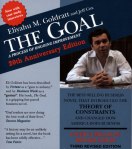 Last Friday, I presented my synopsis of the business book classic, The Goal: A Process of Ongoing Improvement by Eliyahu M. Goldratt & Jeff Cox. It is a genuine multi-year best seller, and now I know why. It is an incredibly useful, helpful, practical book. Written in fable form, it is set in a factory, but, it is useful for getting any company, any organization, and really, any human life back on the “best track.”
Last Friday, I presented my synopsis of the business book classic, The Goal: A Process of Ongoing Improvement by Eliyahu M. Goldratt & Jeff Cox. It is a genuine multi-year best seller, and now I know why. It is an incredibly useful, helpful, practical book. Written in fable form, it is set in a factory, but, it is useful for getting any company, any organization, and really, any human life back on the “best track.”
Here are the key points that I included on my handout for my presentation:
Why is this book worth our time? It deals with this key issue:
We are not as productive, as profitable, as we could be. Some thing (some one, some process) is holding us back. Don’t let this hold you back.
And here’s the solution that the book describes, in usable detail:
• Be crystal clear about your goal.
• Identify your bottleneck – what is keeping you from your goal?
• Get rid of the bottleneck.
• Now, identify your next bottleneck. (There will be; there will always be!; a next bottleneck).
The book lists the five steps of the process to follow:
#1 — IDENTIFY the system’s constraint(s).
# 2 — Decide how to EXPLOIT the system’s constraint(s).
# 3 — SUBORDINATE everything else to the above decision.
# 4 — ELEVATE the system’s constraint(s).
#5 — WARNING!!!! If in the previous steps a constraint has been broken, go back to step 1, but do not allow INERTIA to cause a system’s constraint.
Here is a more complete description of the problem facing many organizations (and people):
• You are not clear about your goal. (What is in front of your face makes you forget the bigger picture. You may not have even ever gotten clear on the bigger picture – your “goal”).
• You (your organization) are not productive, or profitable, in all the ways you could be
• Something is slowing you down – something is causing the bottleneck
• You don’t know what this problem is
• You don’t know how this problem interacts with other problems
• Once you identify it, and “fix it,” then… you have to repeat the process to find the next new problem. In other words, there is always a slowest point, a “bottleneck” – that you can make much less of a bottleneck
• And, though you want to identify a machine, a piece of software, something physical/tangible, a person, as the bottleneck, it is very likely that the bottleneck is a process bottleneck. Look for the process bottleneck.
And here are my takeaways from the book:
1. The Theory of Constraints (TOC) means:
there is a (current) constraint (bottleneck). Find the constraint, fix it, get a better process, then find the next restraint: (“A chain is no stronger than its weakest link”).2. So –
• do you have the right equipment (software; tools)?
• do you have the right people?
• do you have the right processes?3. When time is short, you get moving….
• Maybe we should always “pretend” that time is short.
There are reasons that books sell over the long haul. Usually, they deal with the true “basics” of success at business (and all-of-life) endeavor. This book does that very well, and does not disappoint.
